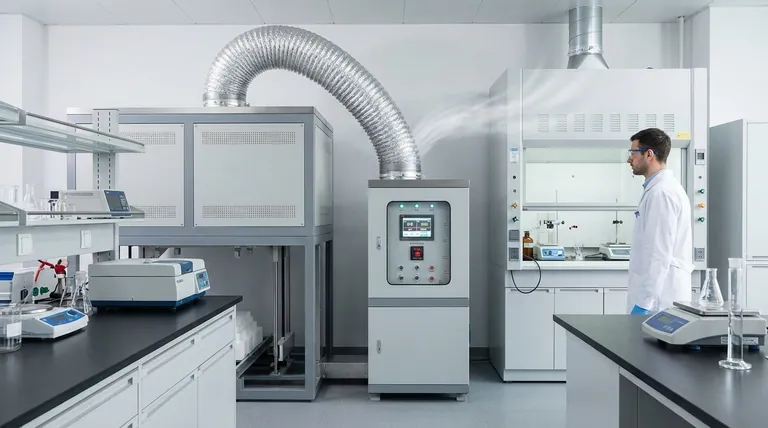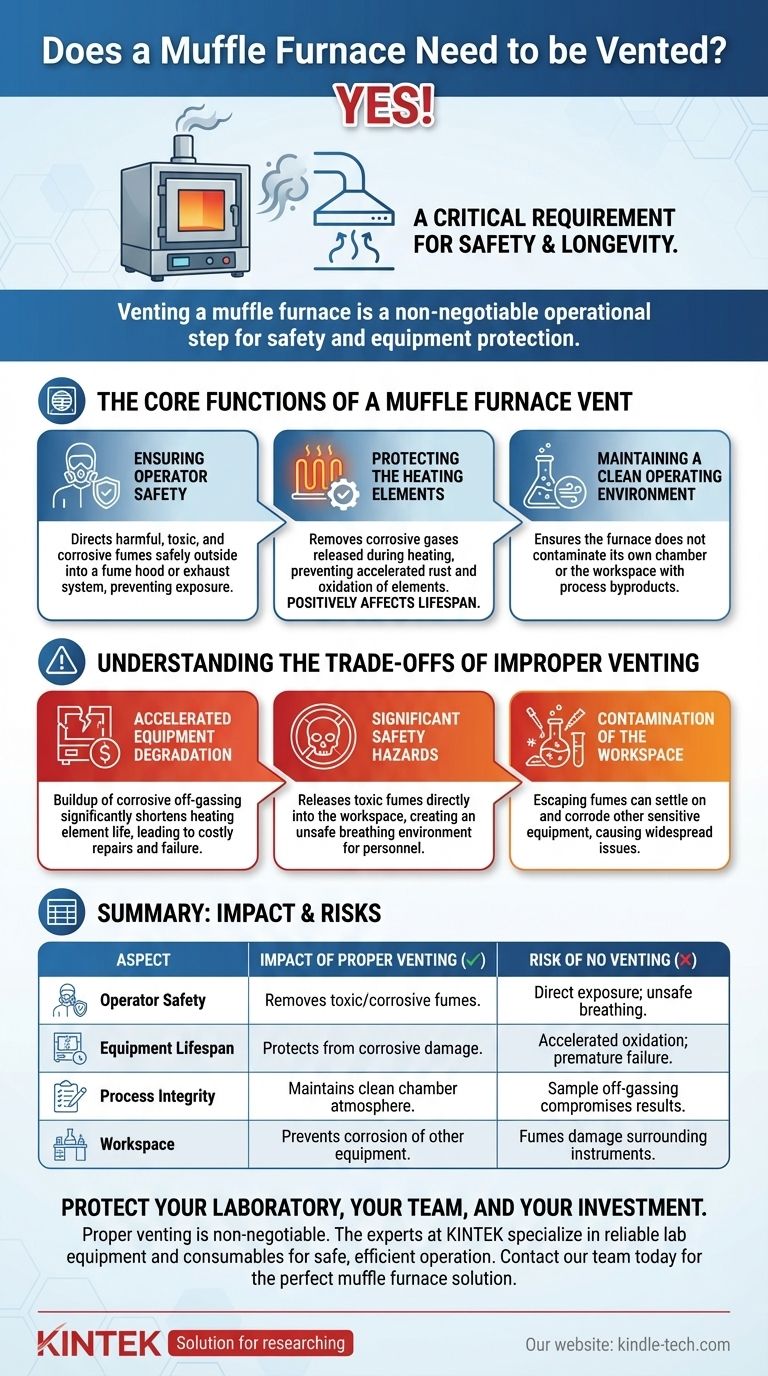Yes, a muffle furnace must be properly vented. This is not merely a recommendation but a critical requirement for safe operation, equipment longevity, and the integrity of your work. The venting system is designed to actively remove potentially hazardous or corrosive fumes, vapors, and gases that are released from materials during the high-temperature heating process.
Venting a muffle furnace is a non-negotiable operational step. It serves two primary, equally important functions: protecting the operator from potentially toxic fumes and protecting the furnace's internal components from the corrosive byproducts of the heating process itself.

The Core Functions of a Muffle Furnace Vent
Understanding why venting is essential involves looking at its impact on safety, the equipment, and the surrounding environment.
Ensuring Operator Safety
Many processes performed in a muffle furnace, such as ashing organic matter or heat-treating materials with coatings, release fumes. These byproducts can be toxic, corrosive, or create an oxygen-deficient atmosphere if allowed to accumulate in the workspace.
A proper vent directs these harmful emissions safely outside, typically into a laboratory fume hood or a dedicated exhaust system.
Protecting the Heating Elements
The gases and vapors released from samples at high temperatures can be highly corrosive. If these byproducts are not removed, they will remain trapped inside the furnace chamber.
This corrosive atmosphere directly attacks the electric heating elements, causing them to rust and oxidize at an accelerated rate. As stated in technical documentation, venting is a direct factor that positively affects the lifespan of the elements.
Maintaining a Clean Operating Environment
A muffle furnace is designed to operate in an environment free of corrosive gases and flammable materials. The venting system is crucial for ensuring the furnace does not contaminate its own operating environment with the very substances it is designed to be protected from.
Understanding the Trade-offs of Improper Venting
Failing to vent a muffle furnace is not a cost-saving measure; it's a decision that introduces significant risks and hidden costs.
Accelerated Equipment Degradation
The most immediate consequence of not venting is damage to the furnace itself. The buildup of corrosive off-gassing will significantly shorten the life of the heating elements, leading to premature failure and costly repairs.
Significant Safety Hazards
Without venting, you are releasing all process fumes directly into your workspace. This exposes personnel to potentially toxic chemicals and creates an unsafe breathing environment, which is an unacceptable risk in any professional setting.
Contamination of the Workspace
Fumes that escape the furnace can settle on and corrode other sensitive equipment in the room. This can lead to widespread equipment issues far beyond the furnace itself.
Making the Right Choice for Your Application
Implementing a proper venting strategy is straightforward and essential for achieving your goals.
- If your primary focus is operator safety: The non-negotiable first step is to ensure all fumes are actively ducted from the furnace's vent port to an external exhaust system, like a fume hood.
- If your primary focus is equipment longevity: Consistently using the furnace's air vent prevents the buildup of corrosive gases, directly protecting the heating elements from oxidation and maximizing the unit's service life.
- If your primary focus is process accuracy: Proper venting ensures that off-gassing from your sample does not create an unintended and uncontrolled atmosphere within the chamber that could compromise your results.
Properly venting your muffle furnace is the single most important step for ensuring safe, reliable, and long-lasting operation.
Summary Table:
| Aspect | Impact of Proper Venting | Risk of No Venting |
|---|---|---|
| Operator Safety | Removes toxic/corrosive fumes from the workspace. | Direct exposure to hazardous fumes; unsafe breathing environment. |
| Equipment Lifespan | Protects heating elements from corrosive damage. | Accelerated oxidation and premature failure of elements. |
| Process Integrity | Maintains a clean, controlled chamber atmosphere. | Sample off-gassing can contaminate and compromise results. |
| Workspace | Prevents corrosion of other sensitive lab equipment. | Fumes can settle and damage surrounding instruments. |
Protect your laboratory, your team, and your investment. Proper venting is non-negotiable for safe and effective muffle furnace operation. The experts at KINTEK can help you select the right furnace and ensure it is integrated with a proper venting solution for your specific application.
We specialize in supplying reliable lab equipment and consumables, ensuring your laboratory operates safely and efficiently.
Contact our team today to discuss your needs and find the perfect muffle furnace solution for your lab.
Visual Guide

Related Products
- Laboratory Muffle Oven Furnace Bottom Lifting Muffle Furnace
- 1800℃ Muffle Oven Furnace for Laboratory
- 1700℃ Muffle Oven Furnace for Laboratory
- 1400℃ Muffle Oven Furnace for Laboratory
- 1400℃ Laboratory Quartz Tube Furnace with Alumina Tube Tubular Furnace
People Also Ask
- What affects the melting point of a substance? Uncover the Key Factors & Forces
- Do different liquids melt at different rates? Unlock the Science of Melting Points and Material Properties
- What is the temperature limit on a muffle furnace? A Guide to Selecting the Right Model
- Why do we need to use properly some of the laboratory apparatus in the laboratory? The Foundation of Safe and Accurate Science
- What hazard is involved when using a furnace? Protect Your Home from the Silent Killer



















